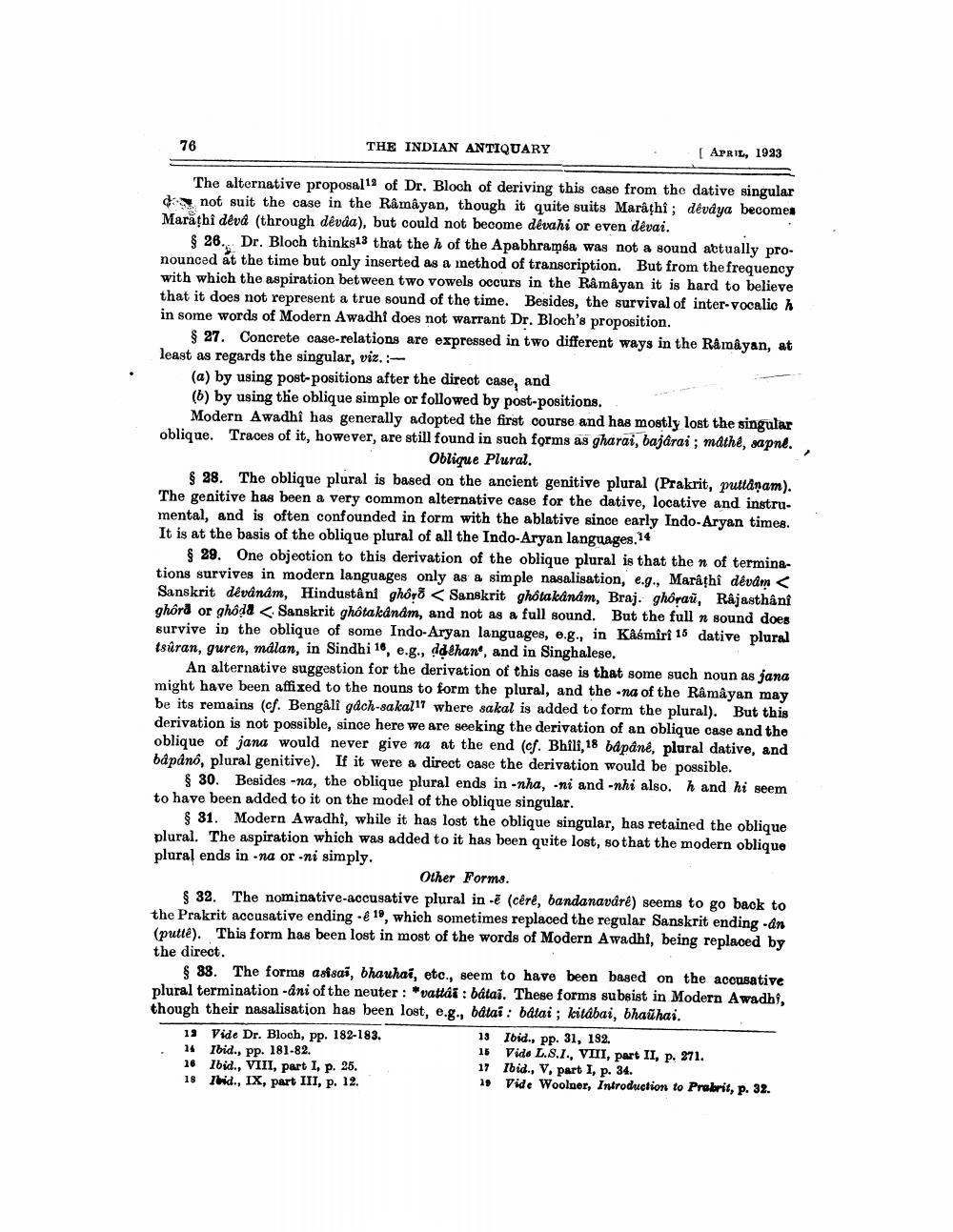________________
76
THE INDIAN ANTIQUARY
[ APRIL, 1923
The alternative proposal19 of Dr. Bloch of deriving this case from the dative singular di not suit the case in the Ramayan, though it quite suits Marathi ; dévaya becomes Marathi deva (through devaa), but could not become devahi or even dévai.
& 28. Dr. Bloch thinkg13 that the h of the Apabhramba was not a sound attually pronounced at the time but only inserted as a method of transcription. But from the frequency with which the aspiration between two vowels occurs in the Ramayan it is hard to believe that it does not represent a true sound of the time. Besides, the survival of inter-vocalich in some words of Modern Awadhi does not warrant Dr. Bloch's proposition.
$ 27. Concrete case-relations are expressed in two different ways in the Ramayan, at least as regards the singular, viz.
(a) by using post-positions after the direct case, and (b) by using the oblique simple or followed by post-positions.
Modern Awadhi has generally adopted the first course and has mostly lost the singular oblique. Traces of it, however, are still found in such forms as gharai, bajárai ; mathé, sapne.
Oblique Plural. $ 28. The oblique plural is based on the ancient genitive plural (Prakrit, puttàņam). The genitive has been a very common alternative case for the dative, locative and instrumental, and is often confounded in form with the ablative since early Indo-Aryan times. It is at the basis of the oblique plural of all the Indo-Aryan languages. 14
& 29. One objeotion to this derivation of the oblique plural is that the n of terminations survives in modern languages only as a simple nasalisation, e.g., Marathi devam Sanskrit dévá nám, Hindustani ghoro < Sanskrit ghôtakånám, Braj. ghôrau, Rajasthani ghord or ghoda < Sanskrit ghôtakdnám, and not as a full sound. But the full n sound does survive in the oblique of some Indo-Aryan languages, e.g., in Kasmiri 15 dative plural tsúran, guren, mdlan, in Sindhi 16, e.g., ddlhan", and in Singhalese.
An alternative suggestion for the derivation of this case is that some such noun as jana might have been affixed to the nouns to form the plural, and the una of the Râmâyan may be its remains (cf. Bengali gach-sakallt where sakal is added to form the plural). But this derivation is not possible, since here we are seeking the derivation of an oblique case and the oblique of jana would never give na at the end (cf. Bhili, 18 bdpane, plural dative, and bápánô, plural genitive). If it were a direct case the derivation would be possible.
& 30. Besides -na, the oblique plural ends in - nha, -ni and -nhi also. h and hi seem to have been added to it on the model of the oblique singular.
31. Modern Awadhi, while it has lost the oblique singular, has retained the oblique plural. The aspiration which was added to it has been quite lost, so that the modern oblique plural ends in-na or-ni simply.
Other Forms. & 32. The nominative-accusative plural in 2 (céré, bandanavdré) seems to go back to the Prakrit accusative ending - ê 19, which sometimes replaced the regular Sanskrit ending -an (putte). This form has been lost in most of the words of Modern Awadhf, being replaced by the direct.
$88. The forms assai, bhauhal, etc., seem to have been based on the accusative plural termination - dni of the neuter : *vatlar : batai. These forms subsist in Modern Awadh. though their nasalisation has been lost, e.g., batai: batai; kitabai, bhaūhai. 13 Vide Dr. Bloch, pp. 182-183.
13 Ibid., pp. 31, 132. 14 Ibid., pp. 181-82.
15 Vide L.S.I., VIII, part II, p. 271. 16 Ibid., VIII, part I, p. 25.
17 Ibid., V, part I, p. 34. 18 Ibid., IX, part III, p. 12.
19 Vide Woolner, Introduction to Prabrit, p. 32.




